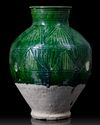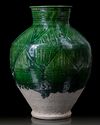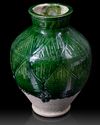A RARE INTACT FATIMID LEED-GLAZED JAR, EGYPT, 10TH-11TH CENTURY
Of pear-shaped form with everted foot, broad flattened shoulder and a narrow slightly everted neck, the shoulder, neck and upper body incised with ring and hatched designs, partially dipped in copper green lead glaze. 25.2 cm. height
CATALOGUE NOTE Green-glazed incised ware from Fatimid Egypt has been described by Oliver Watson as "one of the 'hidden treasures' of Islamic pottery" (Watson 2004, p.285). Surprisingly little is known about this category of wares, for although it is well-attested in the Fustat sherd material, intact examples are extremely rare. This type was first properly documented by Helen Philon (Philon 1980, pp.263ff) who noted the characteristic soft pinkish buff to pale-yellow body and the lead-fluxed copper glaze which typically stops short of the foot. The finest extant example is in the al-Sabah Collection in Kuwait, attributed by Watson to the twelfth century (Watson 2004, pp.284-5). The present example is closer in shape to the lustre jars of the Fatimid period and is likely to be an earlier form dating to the tenth or eleventh century. An eleventh- or twelfth-century green-glazed vase in the Los Angeles County Museum of Art displays the same proportion of incised and glazed decoration as our jar (LACMA inv.no.M.2002.1.171) and a similar cut foot. A turquoise-glazed jar from the same period has comparable incised hatched decoration (LACMA inv.no.M.2002.1.201).





